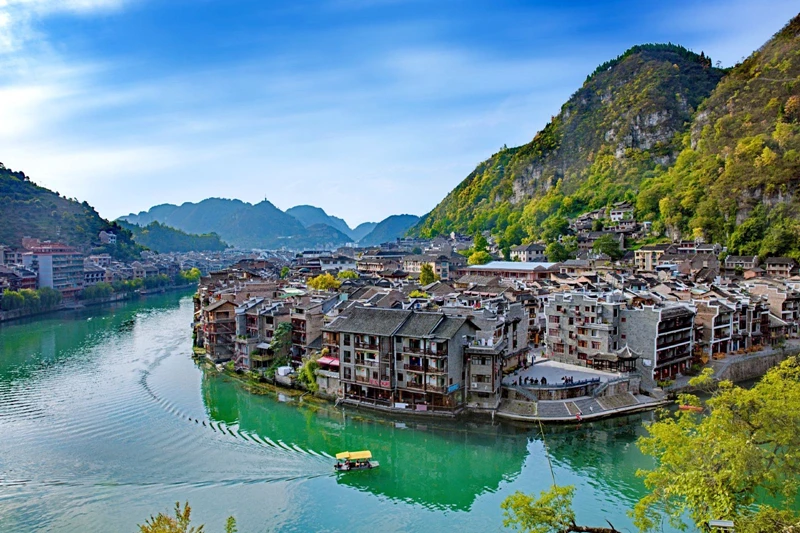Zhenyuan Ancient Town (Zhenyuan Ancient Town) is located in zhenyuan county, Qiandongnan, on the banks of Wuyang River. The river meanders through the city in an "S" shape, forming a style similar to Taiji diagram, so it is also called Bagua Ancient Town. Every summer, the surrounding tourists gather here in succession, which is very lively.
Zhenyuan county City is divided into two parts by Wuyang River, and the north shore is the place where the old soldiers were stationed, which is called the Acropolis. Nan 'an is a place where administrative agencies and civilian businesses gather, which is called Fucheng. Up to now, there are still some ruins of ancient city walls and gates in the city. There are two bridges on Wuyang River, the west of which is newly built, and the locals call it the new bridge. The Zhusheng Bridge on the east is the landmark building of Zhenyuan Ancient City, and the locals call it the old bridge. Between the old and new bridges is the traditional boundary of the ancient town. The ancient town consists of three streets (Xinzhong Street, Xinglong Street and Shuncheng Street) connected end to end. Similar to other ancient towns, both sides of the street are inns, restaurants and shops.
Zhusheng Bridge is a landmark of the ancient town. There is a three-story pavilion on the bridge, which was once the main channel of Hunan-Guizhou Unicom, and it has been known as the "throat of Hunan-Guizhou" since ancient times. Every night, the Zhusheng Bridge is brightly lit, and the lights are reflected by the river, which is quite spectacular. It is suitable for strolling on the bridge or taking pictures.
On the east side of Zhusheng Qiaotou is Yuping Mountain, and more than 40 ancient buildings in Ming and Qing Dynasties are built on the mountain, which is quite spectacular. These ancient buildings are built according to the mountain, and they are integrated with cliffs, ancient trees, vines and caves. The Jade Emperor Pavilion at the top is the highest point of Zhenyuan ancient town and a good place to watch the panoramic view of the ancient city.
There is a ruined ancient Great Wall on the back of Yuping Mountain, which was the site where the Ming army fought against the border people. If you are interested and have physical strength, you may wish to visit this scenic Great Wall with a vicissitudes of life. Miaojiang Great Wall and Yuping Mountain jointly sell tickets and can play together.
In addition to the three main streets, there are also four-way alleys, Fuxing alleys and Renshou alleys in the ancient city, which are crooked but extend in all directions. Walking in the roadway, ancient wells, ancient houses and some old workshops can evoke some childhood memories.
After visiting the ancient city, you can rent a bicycle at Xinglong Street and ride a bicycle around zhenyuan county City like a local. The air in the suburbs is fresh, and the green trees, wild flowers and farmland along the way make you excited to leave the city. You can also rent a boat at the ticket office in the upper reaches of the ancient city water and go boating on the Wuyang River, especially at night. It is especially charming to watch the night view of the ancient city on the boat.
There are many inns in the ancient city, so you can choose as you like. It is essential to settle down, eat and drink. There are three special dishes in Zhenyuan ancient city, such as braised pork and stewed goose in Tiexi, which are worth tasting.
full text
opening hours
Open all year round.
Preferential treatment policy
Supplementary notes: 1. Please refer to the introduction of each scenic spot for the preferential policies of internal sub-scenic spots.
产品详情










